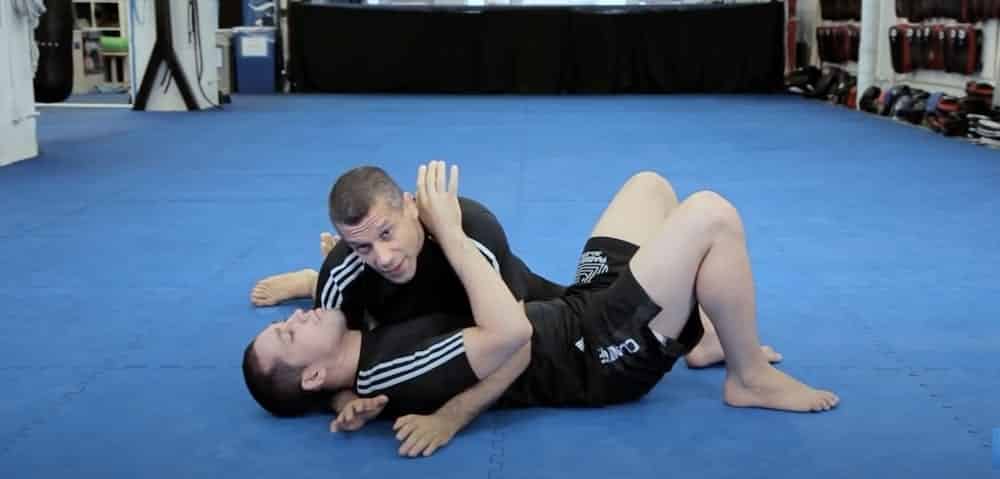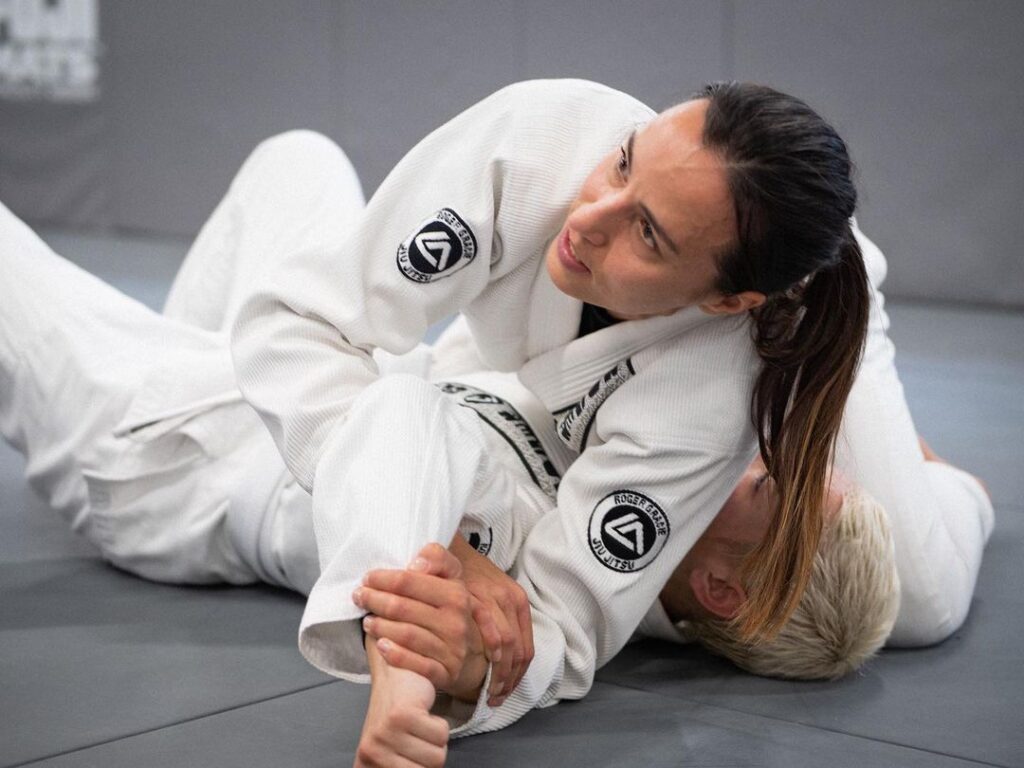Americana Lock – BJJ Technique Explained

When you start out learning Brazilian Jiu JItsu, there is a core group of submissions that you learn first. One of the most simple and effective from that group of submissions is the Americana lock.
The Americana lock is a great submission no matter if you’re a white belt or a black belt. Once you’re able to isolate your opponent’s arm and lock the submission in it is just about game over.
For those starting out in grappling, here is everything you need to know about the Americana lock. We’re going to go into everything from how it works, who invented it, and how to do it from different positions.

Who came up with the Americana Armlock?
No one person can be really accredited with coming up with the Americana armlock. It is used in just about every type of grappling that has ever existed.
One false origin comes from Rolles Gracie that claimed American wrestler Bob Anderson showed it to him in the 1970s. Although the word Americana can be traced back around the time the late Rolles Gracies was born in 1951. A Brazilian newspaper O Diario de Noticias called a kimura an “Americana” when describing the Kimura vs Helio Gracie match.
Factually, the Americana submission has been around for generations before it got the name Americana or keylock. In submission wrestling it’s called the figure 4 arm lock and in Judo it’s called Ude Garami.
How does the Americana Lock work?
The Americana lock is a classic fulcrum movement that puts immense pressure on the victim’s shoulder. Going 2 arms on 1 for control to isolate the opponent’s arm from their body.
It primarily only works with an opponent on their back, but can work from bottom against novice grapplers.
Once you have isolated their arm and have it controlled on the mat with grips you lift up on the elbow. Forcing them to either tap or have the tendons in their shoulder torn.
Basic Americana Armlock from side control
When learning how to do submissions from side control, they all start from learning how to control the position. What you must know is to control the head, stay tight, and give no space.
Starting with your knees, they must be connected to your opponent’s armpit and hip. You must keep this connection in order to do the traditional Americana Armlock.
Next is controlling your opponent’s head. You can either put your arm under their head or put your forearm on their throat. Do whichever is your preference, but be sure to give good downward pressure on your opponent.
The third thing you need to remember in side control is your chest must be on your opponent’s with no space. If you’re too far over, they will reverse you and too far away, they will recover guard. Once you remember these three things, you can do the Americana armlock.
Start by going two arms on one to isolate the opponent’s arm. Place it on the ground at a 90 degree angle facing up.
Next step is to control their wrist with your top arm and put your elbow against their neck or head. This prevents them from turning in and attempting to defend.
Then your other goes under your opponent’s arm and you grab your own wrist palm down. If you want a little more control on their arm, turn your wrists like you’re revving a motorbike.
To finish the submission slightly lift up on your opponent’s elbow with your arms to set in the pressure.
The Mousetrap Americana Lock
A sneaky set up from side control is the mousetrap Americana lock. This technique has this name, because your opponent gets their arm caught like a mouse baited into a trap.
Start by underhooking your opponent’s arm with your inside arm and cup their shoulder. With their arm controlled, you take your other arm and loop it around your opponent’s head and cup your own ear.
When You do this, you are laying a trap for your opponent to defend. If they decide to try and defend, they will bring their isolated arm up to defend.
As they bring their arm up, you take your hand off your ear and grab their wrist. Planting your opponent’s arm to the mat and enabling you to go right into the Americana lock.
Americana lock from mount
When you’re in the mount position, an Americana lock is a common go to submission. Remember to keep your knees tight against your opponent and your weight centered on their chest. Otherwise, they will be able to bridge and reverse you.
A good grappler when mounted will have their arms in tight to defend against submissions. What you’ll need to do is go 2 on 1 and push their arm to the mat.
Your top arm grabs their wrist and your elbow frames against their head just like with side control. Then your other hand goes under your opponent’s arm and you grab your own wrist.
To get a little more pressure on the lock, you can turn your hip to the mat. Then lock on the pressure just like you would from side control.
Americana lockfrom half guard in Gi
A traditional Americana lock from half guard works the same as the technique from side control. Although it is not as effective and a lower percentage move from this position.
But there is a method involving the use of your opponent’s Gi that makes it really effective. You start in half guard and your opponent is framing on your neck with his arm.
To get it off, you can take out their Gi and pass it over their wrist to your other hand. You could pass from here, but you could also do a tight Americana using your opponent’s own Gi.
Pass their Gi back to your other hand and use it to hold their arm to the mat. Their arm is stuck to the mat and they can’t move.
With their arm stuck, you bring your arm over your opponent’s head. Before you lock your arms together, use your elbow to push their head away to prevent them from turning in.
Then while keeping the opponent’s lapel, grab their wrist, and lift their arm up for the submission.
Kesa Gatame Americana Lock
From Kesa Gatame side control, you can do a variation of the Americana lock with your legs. In catch wrestling it’s called a scarf hold armlock.
In Kesa Gatame, you control your opponent’s head and this leaves their inside arm isolated. What you do is slide your bottom leg under your opponent’s arm and lock their wrist to the mat.
Once their arm is pinned to the mat, you lean forward to put pressure on their shoulder for the tap.
The armlock chain
The Americana lock is part of an arm lock chain from side control. Those submissions include the Americana, kimura and straight armbar.
All of these submissions are connected to one another if one technique fails you can go to another.
For example: If you go for an Americana and your opponent straightens their arm out, you can now try a straight armbar. Also if they turn their arm down, you could also try a kimura.
This is just a simple chain of submissions, you should know when you start learning Jiu Jitsu.
Tips for doing the Americana lock
While the Americana lock is very simple and basic, you have to pay attention to the details. Here are the tips to remember for doing the Americana Armlock.
- No Space: From the top position, you must not give any space to your opponent.
- Keep Weight Centered: You have to keep your weight centered on your opponent’s chest to get a successful Americana armlock. Too far over, they will reverse you and too far back will allow them to recover guard.
- Knee Placement: Whether you’re doing the Americana lock from side control or mount, knee placement is important for controlling your opponent. In side control, keep your knees in the hip and armpit, while in mount keep them tight to their body.
- Arm on the mat: To put on the pressure, your opponent’s arm must be held on the mat. If it’s off the mat, they can defend and work to escape.
- Give Good Shoulder Pressure: A normal way to block an Americana is by framing, but if you’re giving good shoulder pressure that’s hard to accomplish. Keep good shoulder pressure on your opponent to keep them from framing.
- Isolate the arm: Isolate your opponent’s arm by using your elbow to block their head. When you do this they aren’t able to turn into you and defend.
- Turn your wrists: When you have figure 4 grips and want to make it extra tight, turn your wrists like you’re revving a motorbike. Doing this makes your grip a little tighter and keeps their arm on the mat.
- Slightly Lift Their Elbow: To finish the submission, remember to slightly lift their elbow up. That small motion locks on the pressure and forces them to tap.






